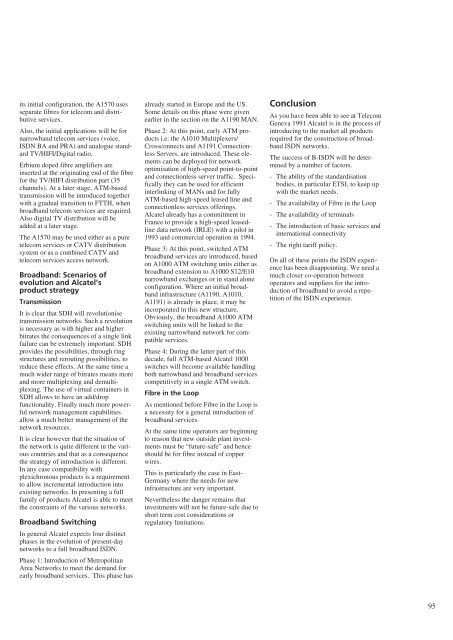Norsk Telefoningeniørmøte 1992 - Telenor
Norsk Telefoningeniørmøte 1992 - Telenor
Norsk Telefoningeniørmøte 1992 - Telenor
Create successful ePaper yourself
Turn your PDF publications into a flip-book with our unique Google optimized e-Paper software.
its initial configuration, the A1570 uses<br />
separate fibres for telecom and distributive<br />
services.<br />
Also, the initial applications will be for<br />
narrowband telecom services (voice,<br />
ISDN BA and PRA) and analogue standard<br />
TV/HIFI/Digital radio.<br />
Erbium doped fibre amplifiers are<br />
inserted at the originating end of the fibre<br />
for the TV/HIFI distribution part (35<br />
channels). At a later stage, ATM-based<br />
transmission will be introduced together<br />
with a gradual transition to FTTH, when<br />
broadband telecom services are required.<br />
Also digital TV distribution will be<br />
added at a later stage.<br />
The A1570 may be used either as a pure<br />
telecom services or CATV distribution<br />
system or as a combined CATV and<br />
telecom services access network.<br />
Broadband: Scenarios of<br />
evolution and Alcatel’s<br />
product strategy<br />
Transmission<br />
It is clear that SDH will revolutionise<br />
transmission networks. Such a revolution<br />
is necessary as with higher and higher<br />
bitrates the consequences of a single link<br />
failure can be extremely important. SDH<br />
provides the possibilities, through ring<br />
structures and rerouting possibilities, to<br />
reduce these effects. At the same time a<br />
much wider range of bitrates means more<br />
and more multiplexing and demultiplexing.<br />
The use of virtual containers in<br />
SDH allows to have an add/drop<br />
functionality. Finally much more powerful<br />
network management capabilities<br />
allow a much better management of the<br />
network resources.<br />
It is clear however that the situation of<br />
the network is quite different in the various<br />
countries and that as a consequence<br />
the strategy of introduction is different.<br />
In any case compatibility with<br />
plexichronous products is a requirement<br />
to allow incremental introduction into<br />
existing networks. In presenting a full<br />
family of products Alcatel is able to meet<br />
the constraints of the various networks.<br />
Broadband Switching<br />
In general Alcatel expects four distinct<br />
phases in the evolution of present-day<br />
networks to a full broadband ISDN.<br />
Phase 1: Introduction of Metropolitan<br />
Area Networks to meet the demand for<br />
early broadband services. This phase has<br />
already started in Europe and the US.<br />
Some details on this phase were given<br />
earlier in the section on the A1190 MAN.<br />
Phase 2: At this point, early ATM products<br />
i.e. the A1010 Multiplexers/<br />
Crossconnects and A1191 Connectionless<br />
Servers, are introduced. These elements<br />
can be deployed for network<br />
optimisation of high-speed point-to-point<br />
and connectionless server traffic. Specifically<br />
they can be used for efficient<br />
interlinking of MANs and for fully<br />
ATM-based high-speed leased line and<br />
connectionless services offerings.<br />
Alcatel already has a commitment in<br />
France to provide a high-speed leasedline<br />
data network (IRLE) with a pilot in<br />
1993 and commercial operation in 1994.<br />
Phase 3: At this point, switched ATM<br />
broadband services are introduced, based<br />
on A1000 ATM switching units either as<br />
broadband extension to A1000 S12/E10<br />
narrowband exchanges or in stand alone<br />
configuration. Where an initial broadband<br />
infrastructure (A1190, A1010,<br />
A1191) is already in place, it may be<br />
incorporated in this new structure.<br />
Obviously, the broadband A1000 ATM<br />
switching units will be linked to the<br />
existing narrowband network for compatible<br />
services.<br />
Phase 4: During the latter part of this<br />
decade, full ATM-based Alcatel 1000<br />
switches will become available handling<br />
both narrowband and broadband services<br />
competitively in a single ATM switch.<br />
Fibre in the Loop<br />
As mentioned before Fibre in the Loop is<br />
a necessity for a general introduction of<br />
broadband services.<br />
At the same time operators are beginning<br />
to reason that new outside plant investments<br />
must be “future-safe” and hence<br />
should be for fibre instead of copper<br />
wires.<br />
This is particularly the case in East-<br />
Germany where the needs for new<br />
infrastructure are very important.<br />
Nevertheless the danger remains that<br />
investments will not be future-safe due to<br />
short term cost considerations or<br />
regulatory limitations.<br />
Conclusion<br />
As you have been able to see at Telecom<br />
Geneva 1991 Alcatel is in the process of<br />
introducing to the market all products<br />
required for the construction of broadband<br />
ISDN networks.<br />
The success of B-ISDN will be determined<br />
by a number of factors.<br />
- The ability of the standardisation<br />
bodies, in particular ETSI, to keep up<br />
with the market needs.<br />
- The availability of Fibre in the Loop<br />
- The availability of terminals<br />
- The introduction of basic services and<br />
international connectivity<br />
- The right tariff policy.<br />
On all of these points the ISDN experience<br />
has been disappointing. We need a<br />
much closer co-operation between<br />
operators and suppliers for the introduction<br />
of broadband to avoid a repetition<br />
of the ISDN experience.<br />
95
















